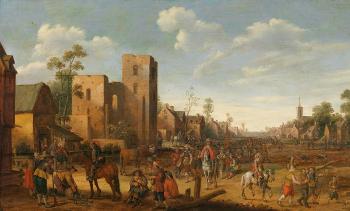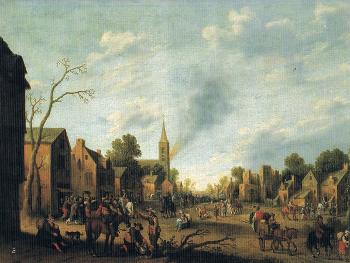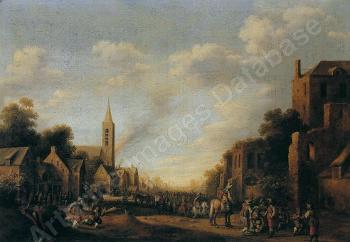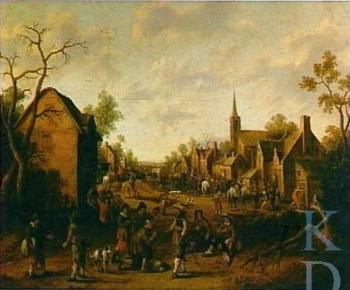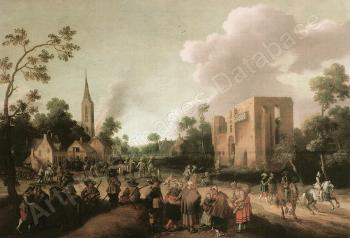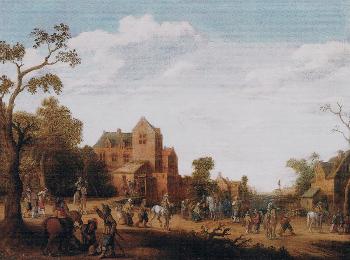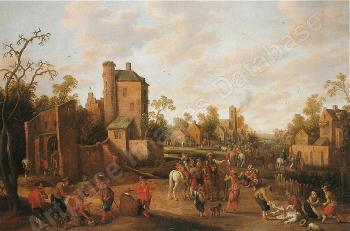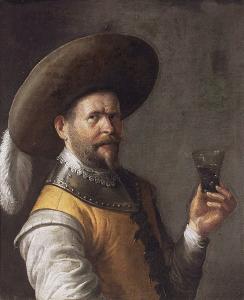Joost Cornelisz. Droochsloot
Soldiers pillaging a village
Oil on panel : 75 X 110 cm
Signed and dated 1650 lower left
Sold at Christie’s Amsterdam, 18/11/93
For 130.000 DG = 60.827 €
This is a comparative item

Painting for Sale
In short
Droochsloot, who possibly studied painting in Antwerp, worked almost exclusively in his native Utrecht.
Droochsloot painted several representations of Spanish soldiers plundering Dutch villages and farms and attacking travellers. All the other versions are much larger than ours. The Dutch war of independence, the so-called Eighty Years’ War, ended in 1648, when Spain finally accepted the creation of an independent Dutch Republic.
About Joost-Cornelisz. Droochsloot
Dutch painter
Utrecht 1586 – 1666 Utrecht
Painter of genre scenes, usually with peasants, village and town views and landscapes (including some winter landscapes) and a few religious and allegorical subjects (mostly at the start of his career).
It is not known whom our painter studied under. Seeing the Flemish character of his oeuvre some scholars think he might have studied in Flanders, in Antwerp.
Droochsloot remained in Utrecht his whole life, except for a period at the start of his career: his earliest painting, dated 1615, was made at The Hague, but from 1616 onwards he was back in Utrecht. That year was his first inscription as a member of his birthplace Painter’s Guild of Saint Luke. He was Dean in 1623, 1641 and 1642.
Master of six pupils: best known are his own son, Cornelis Droochsloot (1640 – after 1673), and Cornelis Duck (circa 1600 – 1667, painter of genre scenes, regularly with military).
Droochsloot died in 1666, one year after his wife, Agnieten van Rijnevelt. The couple had at least eleven children, but all of them, except for the painter Cornelis, died before them. Actually Cornelis married May 3rd 1666, with his father as his witness, who died just a few days later (he was buried the 14th).Three of the children of Joost-Cornelisz. and Agnieten died from the plague in 1636. In five years time, of which 1636 was clearly the worst, at least 4300 inhabitants of Utrecht died of it, almost 15% of the total population of some 30.000 inhabitants. And then one does not take into account other killing diseases, such as cholera.
Our painter’s first name should be pronounced Joost-Corneliszoon. The “z.” at its end stands for “zoon”, “son”.
Droochsloot was a versatile and productive painter. The Central Museum of his hometown Utrecht holds 15 of his paintings, showing the diversity of his work.
On the other hand Droochsloot is also known for the repetitive character of his artistic production, regularly repeating diverse variations in all dimensions of his most successful composition: a village street with houses on both sides with many inhabitants and beggars, sometimes including the Seven Act of Mercy.
One should see the choice for this subject against the background of his own social involvement in his community:
- in 1638 he was elected regent of the Saint Job’s hospital, along the Vleutenseweg, a function that he kept until his death.
The Painter’s Guild of Saint Luke of Utrecht was established in one of the rooms of that Hospital. During the 17th century it was a habit that each year a local artist would offer a painting to this almshouse, which would then be hung in the Regent’s room. Droochsloot had done so in 1628: a landscape with the consolation of Job’s friends.
- in 1642 Droochsloot became deacon of the Dutch Reformed Church.
About the political and military background of our painting
Our painting represents a scene that occurred during the Eighty Years' War. This Dutch war of independence from Spain, was a long, slow war that lasted from 1568 until 1648. The war started of as a Protestant uprising in Flanders and in Holland against the Catholic Spanish Habsburg. It ended with the Peace of Westphalia in 1648: Spain recognized an independent Republic of the Seven United Provinces, Holland, while Flanders remained Spanish.
The War can be divided into four phases:
- 1568 until circa 1600: this period ends with Prince Maurice taking a lot of towns from the Spaniards.
- 1609 – 1621: the Twelve Years’ Truce.
- 1621 – 1625: important Spanish successes, for example the fall of Breda in 1625, six weeks after the Dutch Stadtholder Prince Maurice died.
- 1625 – 1648 : the new Stadtholder Frederick Henry besieged town after town, a relatively slow system that paid of well. The Dutch were lucky: while Spain was regularly in great need of money, with soldiers and mercenaries that could not be paid, they had captured under Admiral Piet Hein the famous Spanish silver fleet in Cuba in 1628. All this money could now be used for the war.
An offensive and defensive treaty sealed with France in 1635 proved to be very successful and finally forced Spain to accept peace with an independent Dutch Republic: the Treaty of Westphalia or Munster of 1648.
Typical for the Eighty Years’ War is the lack of uniforms. These appeared only at the end of the 17th century. 16th and 17th century soldiers recognized each other by colours: orange (sometimes also blue or black) for the Dutch, red for the Spanish. These colours appeared in sashes, worn round the middle, and in plumes, attached to the hats and helmets.
About our painting
The local population, especially the farmers, suffered heavily during the Eighty Years’ War. Plundering of farms and of small villages in enemy territory occurred regularly and was fairly easy. Soldiers and mercenaries were allowed to loot, but each day they were obliged to sell whatever they had stolen to merchants who would be at the centre of their encampment.
Both enemy sides, the Spanish and the Dutch, used numerous mercenaries: Flemish, Walloon, German, French, English, Irish, Scottish, Welsh, even Croatian and Polish soldiers.
The eldest (16th century), best known paintings representing looting soldiers are the different versions of ‘the massacre of the innocents’ by Pieter Brueghel the Elder.
Representations of plundering soldiers from the first half of the seventeenth century have been painted in Flanders by Sebastiaen Vrancx and Pieter Snaeyers, in Holland by Esaias van de Velde and by our Joost Cornelisz. Droochsloot.
A common element in all Droochsloot’s village scenes with soldiers who are plundering is the nationality of the enemies: they are all Spanish, identified by the red colour of their scarfs.
Our painter seems to have painted all these scenes on large panels or canvasses (60/80 cm by 1m/1m20). Our small painting seems to be the exception to that rule.
I also found a village scene, sold at Sotheby’s London in 2006, that has a similar row of houses on the right hand side. Although that was a rather common subject for our painter, it still sold for over 22.000 €.
Why should you buy this painting?
Because it is such a rare and original subject for Droochsloot.
Comparative paintings
Click photos for more details

